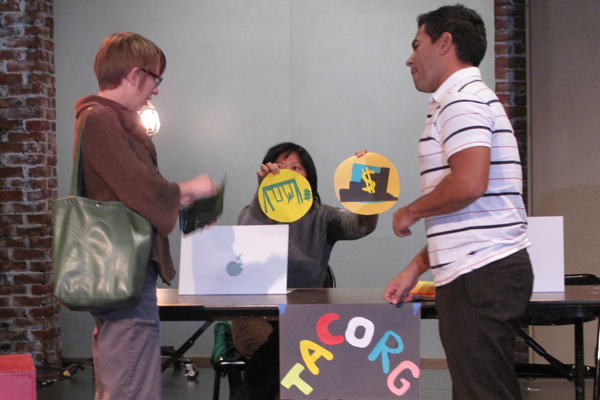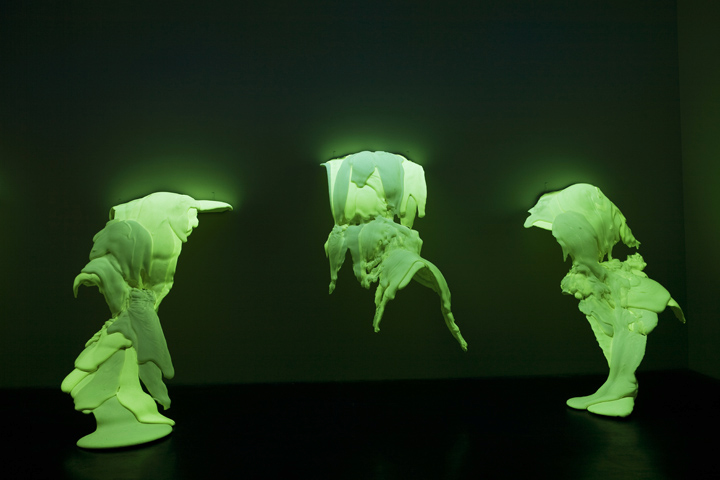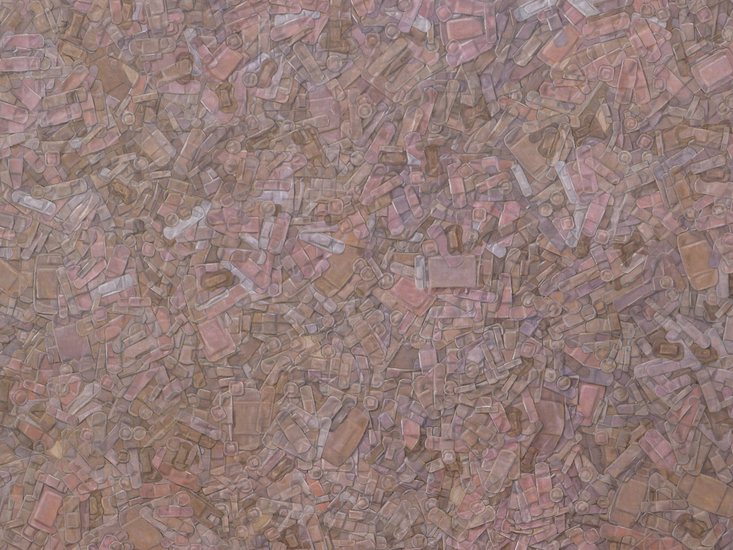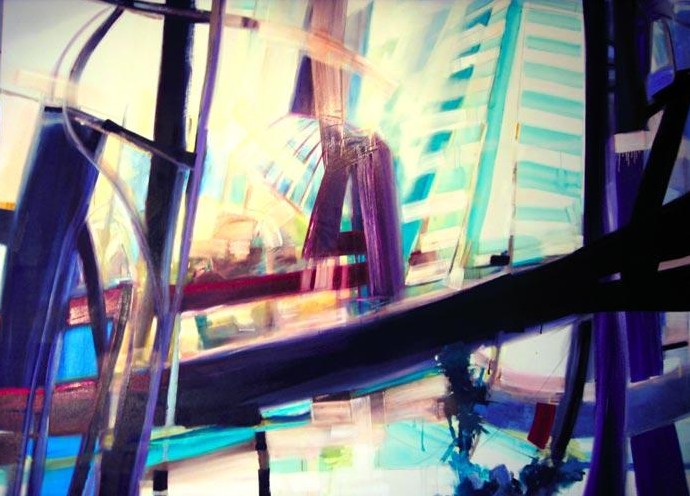
Debating Through the Arts performance and exhibitions are based on the Model United Nations paradigm, a program that simulates activities in the UN General Assembly. Through a dynamic process of exchanging ideas and opinions, artists connect with each other in a collaborative atmosphere that encourages the development of new, creatively inspired ideas and solutions. Exploration and team-building time are deliberately built into the structure, with no pre-determined outcomes, to encourage discovery.
As noted in a recent interview by Christine Palma, Public Affairs Director for KXLU Los Angeles, 88.9 FM, producer and host of "Echo in the Sense," a weekly radio show, "Artists are trained to look at things from various perspectives, they are often more tolerant and empathetic. Due to these enhanced skills and perspectives, Debating Through the Arts co-creators Inez Bush and Jerri Allyn both believe that artists should play a significant role in resolving issues societies are facing locally and globally."

The Performance will commence with teams debating and rebutting a chosen issue, in this case, Cultural Equity, followed by caucusing, then collaboratively developing "creative referendums". Audience members are encouraged to participate throughout the day. The Debate culminates with teams expressing their collective viewpoints via performances, followed by a vote.

Lynda Benglis | A traveling exhibition of the work of American artist Lynda Benglis from the past forty years. The first full-scale survey of Benglis's oeuvre since Dual Natures at the High Museum of Art, Atlanta, 1991, this traveling exhibition highlights works from the 1960s through 2009, including three video works and a selection of ephemera.
Benglis's work continues to challenge artistic norms and exceed easy definition. Initially developed in the 1960s, her singular practice did not fit clearly within the sharp aesthetics of minimalism, or in the overtly political gestures of feminist art. Unlike minimalist sculpture, Benglis's works evoke the organic and the temporary--her sculptures are defined by rivers of vibrant colors and erotic melting forms. Rejecting the formalist influences of modernism, Benglis removes painting from the wall and integrates color into sculpture, capturing sensual experience and creating a visceral tie between the viewer and her biomorphic figures. With this unique combination of sensuousness and punk attitude, Benglis has influenced many generations of artists.

Kristin Calabrese, Monique van Genderen, Mindy Shapero | The exhibitions juxtapose three unique and very different approaches to art making that are each steeped in a distinct dialogue with art from the west coast.
Featuring new paintings by Kristin Calabrese, "Back of my Face," can be read as an attempt to compress the artist's thoughts and feelings into paintings. "Back of my Face" is a poetic title - descriptive of emotions translated from the body and pushed into a surface. Each painting is a closed system that doesn't change with interaction. The works are physical manifestations of areas of conflict, intended as stand-ins for the presence of the artist. Included in the exhibition will be a painting of a broom leaning against the wall like a broom would, a painting of plywood, a painting of 3000 band-aids, as well as several self-portraits showing the artist balancing a potted plant or a pile of spaghettis on her head. The paintings, though the mode of choice is a highly detailed form of realism, are less ruminations on the nature of objects but more an investigation of the relationship between feelings on the inside versus the visible world on the outside.
Monique van Genderen presents an ambitiously scaled installation that simultaneously straddles the interior and exterior of the space, while Mindy Shapero offers a group of objects and two-dimensional works, including one of her largest sculptures to date.

Annabel Emson & Gereon Krebber: All the ifs and whens | In this site-specific collaboration of paintings and sculptures, the artists explore the ideas of transformation and contradiction. For both Emson and Krebber, the process of making the work is fundamental to developing a visual language through which they can communicate the feeling of experience to the viewer. Both quiet and confrontational, these works define and redefine the meanings of process and transformation. Bringing elements of chaos and dissonance into a state of harmony, each work matures from an inchoate state into a fully realized presence.
Annabel Emson's paintings reflect the patterns that arise naturally in the structure of the world around us. Her work explores the psychological drama of the imagination - fantastical and dream-like, each work becomes a performative landscape through which the autobiography of experience is distilled. It is in the suspended spaces between the swaying of depicted figuration and abstraction, that her worlds take shape, merging from rhythmical mark making and application techniques.
The sculptures of Gereon Krebber may remind us of something - a cloud, a giant button, a slice of something meat-like, but the everyday materials, of which they are composed, such as balloons or plastic wrap, are always radically transformed from their original function. Based in London, Krebber regards the spirit of his work as "seriously flippant." Krebber's work is full of contradictions. Working predominantly in a site-specific capacity, he makes installations that are at once symbiotic with the spaces they are created for and yet markedly alien within them.

Yvette Gellis: Ephemera | This series of large paintings by artist Yvette Gellis appear abstract at first viewing but, upon closer examination, reveals discernible fragments of representation. Perhaps Gellis explains it best herself: "the work teeters back and forth between the ambiguity of abstraction and the restraints of representation."
Gellis' painting process begins as a gestural dialogue with particular homes and buildings near her 18th Street Arts Center studio, which she will often document in various states of destruction or decay. As Gellis liberally and deftly applies paint in a series of wide, muscular swaths offset by delicate calligraphic swipes, an impending sense of abstraction emerges. Vantage points are obscured, compositional liberty is taken, angles are askew, and ultimately, what began as a quasi-representational rendering is transformed into a phenomenological, psychological, or even a spiritual response.
Gellis' work first garnered critical praise by writer Constance Mallinson in Art in America for its, "lively repartee between the illusion of deep, infinite space and the immediate surface pleasure of energetic abstract painting."
For a complete calendar of openings and exhibitions throughout Los Angeles go to Artweek.LA.